Tropical Paradise: Hawaiian Carrot Pineapple Cake Recipe
Tucked away in a tropical kitchen, this Hawaiian carrot pineapple cake blends sweet island memories with comforting bakery traditions.
Sunshine-kissed ingredients dance together in a delightful harmony of flavors.
Chunks of ripe pineapple and freshly grated carrots promise a moist, irresistible dessert.
Warm spices whisper stories of Hawaiian landscapes and familiar home kitchens.
Creamy cream cheese frosting adds a luxurious finish that makes every slice feel like a celebration.
Baking this cake connects you to the vibrant culinary spirit of the islands.
I promise this recipe will become your new favorite way to bring a taste of paradise to your table.
What Makes Hawaiian Carrot Pineapple Cake Stand Out
Key Ingredients for Hawaiian Carrot Pineapple Cake
Dry Ingredients:Wet Ingredients:Mix-In Ingredients:Frosting Ingredients:How to Make Hawaiian Carrot Pineapple Cake
Step 1: Prepare the Oven and Baking Pan
Preheat your oven to 350F. Grease a 9×13-inch baking pan thoroughly, ensuring every corner is covered to prevent sticking.
Step 2: Create the Dry Ingredient Mixture
Grab a large mixing bowl and whisk together:Blend these ingredients until they’re evenly combined and look uniform.
Step 3: Mix the Wet Ingredients
In a separate bowl, whisk together:Blend until the mixture looks smooth and slightly frothy.
Step 4: Combine Wet and Dry Ingredients
Pour the wet ingredients into the dry ingredient bowl. Stir gently until everything is well incorporated, creating a consistent batter with no dry patches.
Step 5: Add Delicious Mix-Ins
Carefully fold into the batter:Gently stir to distribute ingredients evenly throughout the batter.
Step 6: Bake the Cake
Transfer the batter to the prepared baking pan.
Spread it evenly using a spatula. Place in the preheated oven and bake for 35-40 minutes.
Check doneness by inserting a toothpick into the center – it should come out clean.
Step 7: Cool the Cake
Remove the cake from the oven and let it cool completely on a wire rack.
This prevents the frosting from melting when applied.
Step 8: Prepare Cream Cheese Frosting
In a mixing bowl, beat together:Mix until the texture becomes smooth and fluffy.
Step 9: Finish the Frosting
Gradually add:Beat until the frosting becomes creamy. If it’s too thick, add a tablespoon of milk to reach a spreadable consistency.
Step 10: Frost and Serve
Spread the cream cheese frosting evenly over the cooled cake. Slice and serve this delightful tropical dessert to your friends and family.
Helpful Tips for Hawaiian Carrot Pineapple Cake
Ways to Customize Hawaiian Carrot Pineapple Cake
Perfect Pairings for Hawaiian Carrot Pineapple Cake
Mix a light, refreshing Hawaiian-style rum cocktail with pineapple juice and a splash of coconut cream to echo the cake’s tropical ingredients.
Serve a scoop of premium vanilla bean ice cream alongside the cake, letting its creamy richness complement the cake’s warm spices and dense texture.
Brew a medium-roast coffee with subtle caramel undertones that will enhance the cake’s sweet nutty profile and provide a perfect warm beverage contrast.
Blend a quick smoothie using fresh mango, passion fruit, and a hint of ginger to create a vibrant, tangy drink that balances the cake’s richness.
How to Store Hawaiian Carrot Pineapple Cake Correctly
FAQs
Yes, you can easily omit nuts from the recipe without affecting the cake’s texture or flavor. Simply skip adding nuts when folding ingredients.
Fresh pineapple works great, but make sure to drain it thoroughly to prevent excess moisture in the cake batter. Chop it into small pieces similar to canned pineapple.
Insert a toothpick into the center of the cake. If it comes out clean with no wet batter, the cake is done. The top should also be golden brown and slightly springy when touched.
Canola oil or coconut oil are excellent alternatives to vegetable oil. They will provide similar moisture and texture to the cake.
Print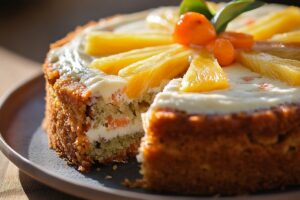
Hawaiian Carrot Pineapple Cake Recipe
- Total Time: 1 hour 5 minutes
- Yield: 12 1x
Description
Hawaiian carrot pineapple cake blends tropical sweetness with classic comfort, creating a moist dessert that celebrates island flavors. Crushed pineapple and fresh carrots deliver rich moisture, while cream cheese frosting provides creamy perfection you’ll savor with each delightful bite.
Ingredients
Main Ingredients:
- 2 cups all-purpose flour
- 1 1/2 cups granulated sugar
- 3 large eggs
- 2 cups shredded carrots
- 1 can (8 ounces / 227 grams) crushed pineapple, drained
Dry Ingredients and Spices:
- 1 teaspoon baking soda
- 1 teaspoon baking powder
- 1/2 teaspoon salt
- 1 teaspoon ground cinnamon
- 1/2 teaspoon ground nutmeg
Wet Ingredients and Optional Add-ins:
- 3/4 cup vegetable oil
- 1 teaspoon vanilla extract
- 1/2 cup chopped walnuts or pecans
- 1/2 cup shredded coconut
Cream Cheese Frosting:
- 8 ounces (227 grams) cream cheese, softened
- 1/2 cup unsalted butter, softened
- 2 cups powdered sugar
- 1 teaspoon vanilla extract
- 1 tablespoon milk
Instructions
- Prepare the oven at 350°F (175°C) and thoroughly coat a 9×13-inch baking pan with grease and flour to prevent sticking.
- In a spacious mixing bowl, thoroughly combine all dry ingredients – flour, sugar, baking soda, baking powder, salt, cinnamon, and nutmeg – using a whisk to eliminate any lumps.
- Create a separate bowl for wet ingredients, whisking eggs, vegetable oil, and vanilla extract until the mixture achieves a smooth, uniform consistency.
- Gradually incorporate wet ingredients into the dry mixture, stirring carefully to ensure complete integration without overmixing.
- Gently fold shredded carrots, drained pineapple chunks, chopped nuts, and coconut flakes into the batter, distributing ingredients evenly throughout.
- Transfer the batter into the prepared baking pan, using a spatula to spread the mixture uniformly and eliminate air pockets.
- Bake for 35-40 minutes, monitoring for a golden-brown surface and checking doneness by inserting a toothpick into the center – it should emerge clean when the cake is fully baked.
- Remove from oven and allow the cake to cool completely at room temperature before applying frosting.
- For the frosting, use an electric mixer to blend cream cheese and butter until achieving a smooth, fluffy texture.
- Gradually add powdered sugar and vanilla extract, continuing to mix until the frosting becomes creamy and spreadable.
- If the frosting seems too thick, incorporate a tablespoon of milk to reach the desired consistency.
- Apply frosting evenly across the cooled cake’s surface, ensuring complete coverage and smooth presentation.
Notes
- Enhance moisture by draining pineapple thoroughly to prevent soggy cake texture.
- Swap nuts with seeds for nut-free version, maintaining delightful crunch and texture.
- Choose room temperature ingredients for smoother mixing and better cake rise.
- Reduce sugar by using alternative sweeteners like honey or maple syrup for healthier option.
- Prep Time: 25 minutes
- Cook Time: 40 minutes
- Category: Desserts
- Method: Baking
- Cuisine: Hawaiian
Nutrition
- Serving Size: 12
- Calories: 324 kcal
- Sugar: 34 g
- Sodium: 130 mg
- Fat: 18 g
- Saturated Fat: 6 g
- Unsaturated Fat: 11 g
- Trans Fat: 0 g
- Carbohydrates: 38 g
- Fiber: 2 g
- Protein: 4 g
- Cholesterol: 55 mg

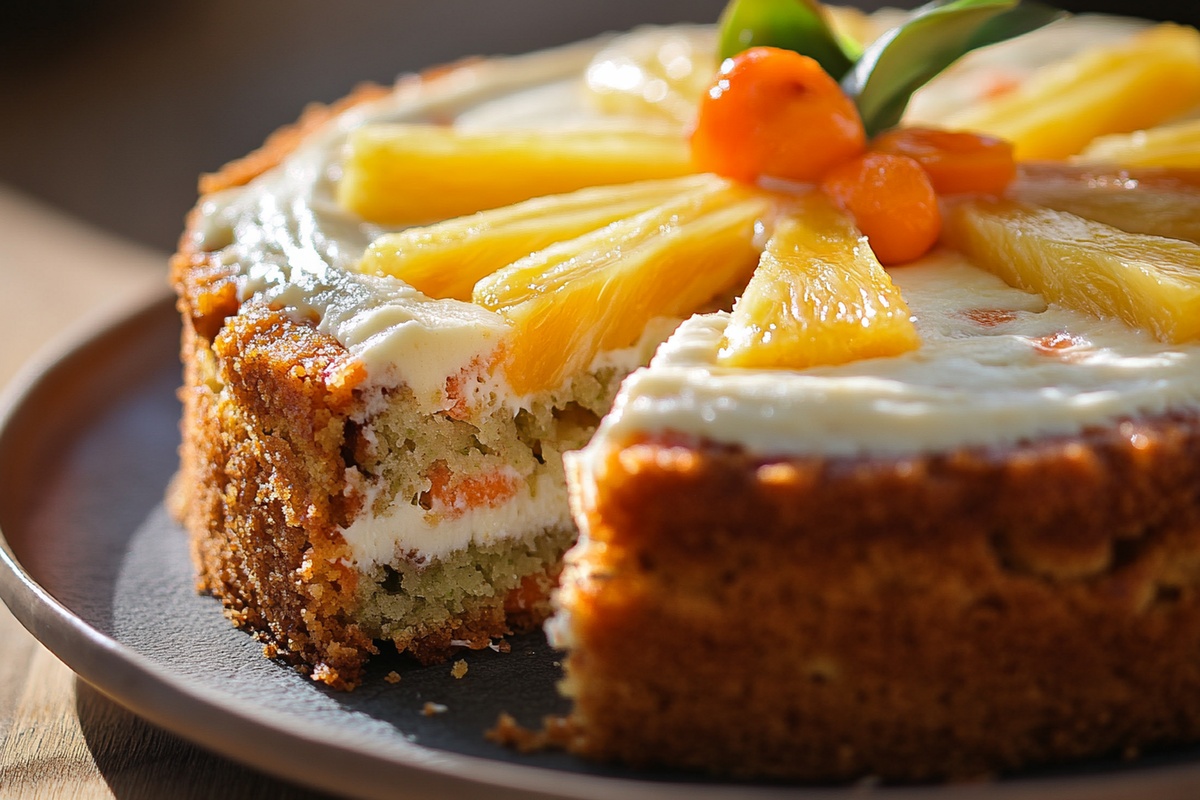
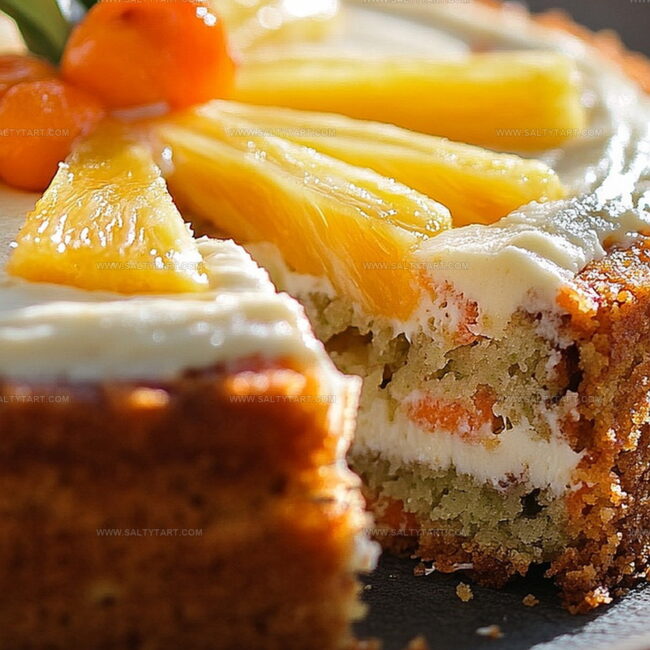
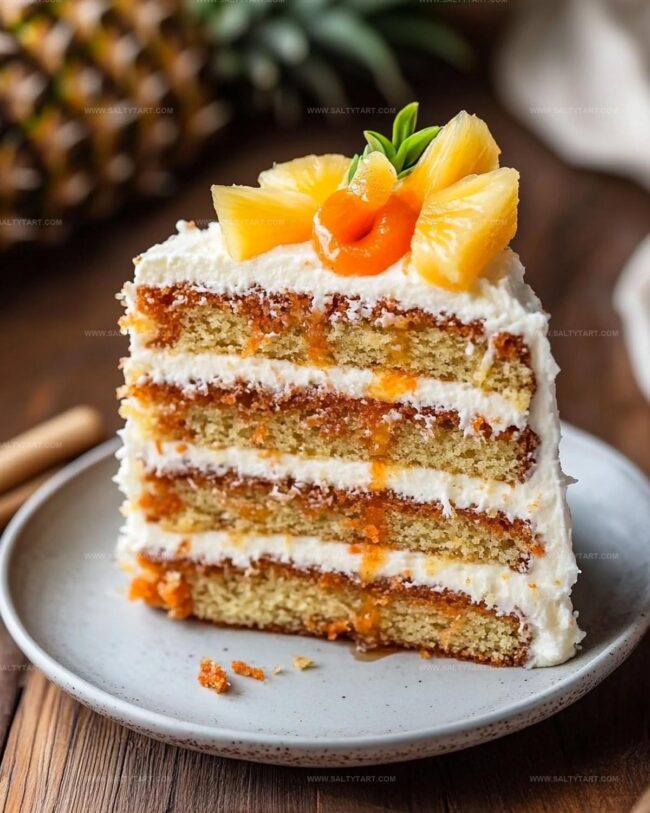
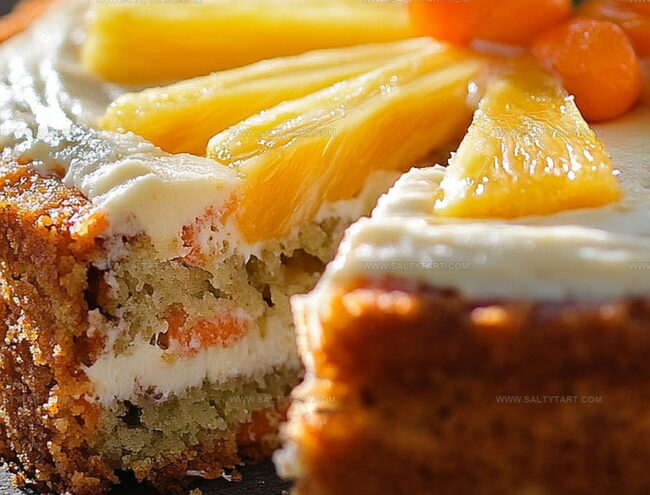
Jess Martinez
Contributing Recipe Writer & Nutrition Consultant
Expertise
Southwestern and Latin American cooking, Nutritional analysis and healthy recipe planning, Cultural food traditions, Modifying traditional dishes for better health
Education
Santa Fe Community College
Certificate in Culinary Arts
Focused on mastering the flavors and cooking methods of traditional Southwestern cuisine.
Jess’s love for bold, homegrown flavors led her straight into the world of Southwestern cooking and cultural nutrition.
After completing her Certificate in Culinary Arts at Santa Fe Community College, she made it her mission to show that good-for-you food can still taste incredible.
At saltytart.com, Jess shares vibrant, health-conscious recipes with roots in tradition but a fresh, modern twist. When she’s not testing new recipes, you’ll find her at local growers’ markets, tending her herb garden, or digging into food history books.